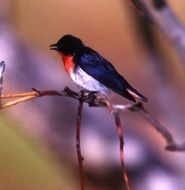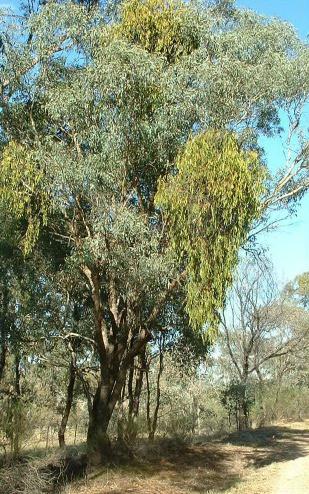There are two parasitic species in the Aranda Bushland – Mistletoe (Amyema miquelii) and Native Cherry (Exocarpus cupressiformis).
Mistletoe (of the family Loranthaceae)
About halfway along the Frost Hollow to Forest Walk, just across the fence and the fire trail at the top of the rural lease, at one edge of the Aranda Bushland, can you see the many eucalypts that have been colonised by the semi-parasitic plant, the Mistletoe . The understorey growth includes the root parasite Cherry Ballart (Exocarpos cupressiformis), which is sometimes called the ‘mistletoe of the soil’.
Mistletoe seeds are usually deposited on eucalypt branches by Mistletoe Birds (Dicaeum hirundinaceum), and less commonly by Honeyeaters (Anthochaera, Phylidonyris, Lichmera and Acanthorhynchus) and Silver Eyes (Zosterops lateralis).
Mistletoe Bird (Dicaeum hirundinaceum)

The black, red and white mistletoe birds feed almost exclusively on the mistletoe berries that tend to stay attached to the mistletoe for long periods.
The digested and deposited mistletoe seeds secrete enzymes that eat holes in the bark of branches. The germinating seed then sends a tendril into this hole. This eventually forms a knobby haustorium (where the mistletoe root and the tree are joined).

Once the mistletoe has established its roots inside the branch, it draws up water and minerals that would otherwise have fed that branch. Mistletoes also supplement these with nutrients produced by their own leaf photosynthesis. Established mistletoe tends to grow quickly unless it is killed by fire or eaten by predators. If more than 50% of the crown is infested, the tree is in trouble. Mistletoe is most commonly found on E. melliodora (Yellow Box) and E. polyanthemos (Apple Box).
But mistletoe will not necessarily damage its host tree if there is abundant fauna in the area that feeds on it. Mistletoe is a good food source as it is rich in sugary nectar and carbohydrates. It is a favourite food for possums and gliders and some butterfly larvae (caterpillars). These larvae can also attract woodland birds to the area, who may then also feed on local beetles and other soil organisms. Mistletoe provides good habitat for birds as it is relatively dense and provides good shade and cover.

Native Cherry (of the family Santalaceae)
The Native Cherry (also known as the Cherry Ballart) is common in the Aranda bushland. It has yellow-green foliage. Cupressiformis means ‘Cypress-like’.
The Native Cherry is a root parasite, i.e. its roots attach themselves to the roots of other plants and obtain nutrients from them, whilst also obtaining nutrients through its own photosynthesis. Its red, pear shaped ‘fruit’ (on swollen sweet stems) tends to be about 1cm in size, with the seed growing outside and below the fruit.